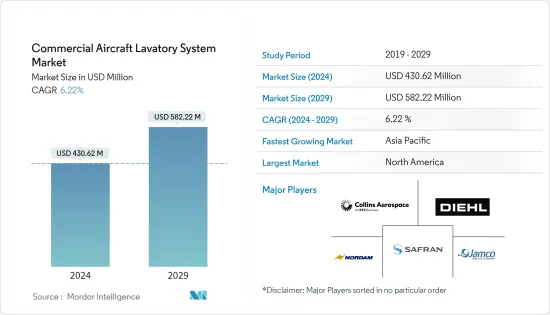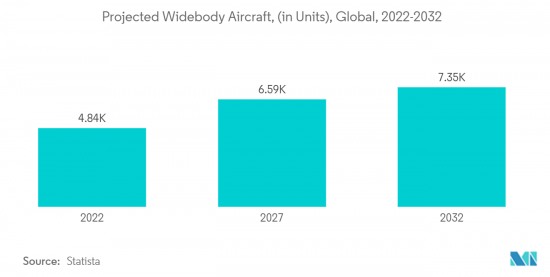PUBLISHER: Mordor Intelligence | PRODUCT CODE: 1405077

PUBLISHER: Mordor Intelligence | PRODUCT CODE: 1405077
Commercial Aircraft Lavatory System - Market Share Analysis, Industry Trends & Statistics, Growth Forecasts 2024 - 2029

The Commercial Aircraft Lavatory System Market size is estimated at USD 430.62 million in 2024, and is expected to reach USD 582.22 million by 2029, growing at a CAGR of 6.22% during the forecast period (2024-2029).
One of the primary drivers in this market is the ever-increasing demand for air travel worldwide. As the global population continues to grow and economies expand, more people are opting for air travel, leading to a higher number of flights. This surge in passenger traffic has a direct correlation with the need for efficient lavatory systems on commercial aircraft. Airlines strive to provide passengers with improved in-flight experiences, and modern, well-maintained lavatories are a crucial aspect of passenger comfort and satisfaction.
Aircraft lavatories are going through continuous innovation as the airlines demand lighter structures to generate more profits through fuel savings by reducing the overall weight. Advanced lavatory systems with features like water-saving technologies and waste reduction mechanisms align with reducing their carbon footprint and adopting eco-friendly practices. Additionally, the importance of hygiene, especially in the wake of global health concerns such as the COVID-19 pandemic, led to innovations in lavatory designs, including touchless fixtures and antimicrobial materials. Few airlines are refurbishing the cabin interior on some of their aging fleet, generating demand for a new lavatory system.
The stringent regulatory environment governing aviation safety and hygiene standards. Aircraft lavatories must adhere to strict regulations and certifications to ensure passenger safety and hygiene. Any new system or component introduced to the market must undergo rigorous testing and meet these regulatory requirements. This can lead to extended development timelines and increased costs for manufacturers. Moreover, retrofitting existing aircraft with new lavatory systems to comply with updated regulations can be a complex and costly endeavor, posing a challenge for both airlines and manufacturers.
Commercial Aircraft Lavatory System Market Trends
Wide-body Segment is Dominate Market Share During the Forecast Period
The number of lavatories installed in an aircraft depends on the passenger-carrying capacity of the aircraft. Hence, the number of lavatories present in wide-body aircraft is much higher compared to narrow-body aircraft. Wide-body aircraft are commonly used for intercontinental flights, which can last for many hours. Passengers on these long flights will likely use the lavatories multiple times, increasing the need for efficient and well-maintained lavatory systems. Also, wide-body aircraft have passengers traveling in Business and First Class. These premium passengers expect high-quality lavatory facilities, which may include more space, upscale amenities, and enhanced hygiene features. Airlines, to improve the passenger experience, are adopting different branded products and designs for their lavatories. Moreover, Wide-body aircraft generally have more interior space than their narrow-body counterparts. This extra space allows for the installation of larger lavatories, which can improve user comfort and accessibility. An increase in wide-body aircraft orders from various airlines across the globe will fuel the demand for more storage bins. In May 2023, Air India placed orders for 70 widebody aircraft, including 20 B787 Dreamliners and 10 B777Xs from Boeing, 34 A350-1000s, and six A350-900s from Airbus.

Asia-Pacific to WItness Highest Growth During the Forecast Period
The aviation industry in Asia-Pacific continues to thrive on a combination of continued robust economic growth, increasing middle-class population, improvements in household incomes, and demographic profiles. Regarding air passenger traffic growth, Asia-Pacific will register a CAGR of over 4.5% over 2040. Tourism growth also defines the state of the commercial aviation market in the region. The increase in Asia-Pacific air passenger traffic is primarily due to China and India. Other countries, like Indonesia, Malaysia, Vietnam, Thailand, and Singapore, among others, are also attracting vast numbers of passengers from various regions around the world, making the airlines introduce new routes to offer better connectivity. According to the International Air Transport Association (IATA), air travel in Asia will surpass North America and Europe by 2030. With such a high rate of growth in terms of passenger traffic, the airlines in the region need to procure new aircraft to cater to the increasing demand. Moreover, the airlines in the Asia-Pacific region are increasingly investing in purchasing and modernizing their aircraft fleets to improve operational efficiency and passenger satisfaction. With the growing orders and deliveries in the area, the demand for aircraft lavatory systems will also witness significant growth. As of February 2023, Indian private airlines such as Air India, Indigo, and others have 1,100 pending aircraft orders from manufacturers. With the increasing aircraft orders and deliveries, simultaneous demand is likely to be generated for lavatory systems from this region during the forecast period.
Commercial Aircraft Lavatory System Industry Overview
The market for commercial aircraft lavatory systems is consolidated and comprises a few players, with some prominent players accounting for a significant market share in 2023. Some of the leading players in the market are Diehl Stiftung & Co. KG, JAMCO Corporation, Safran, The NORDAM Group LLC, and Collins Aerospace (RTX Corporation). However, rivalry among the OEMs is high, with various companies encompassing their offerings in this market. Important strategies such as regional expansion, new product development, and achieving long-term contacts are being implemented by the top players to advance the competitive edge in this market. Companies are significantly investing in developing compact lavatory systems to increase cabin space so that the airlines can squeeze in a more significant number of seats per aircraft to improve their revenue per flight. A considerable engineering and design overhaul is taking place in airport lavatories, accelerated mainly by the COVID-19 pandemic. For instance, Collins Aerospace significantly emphasizes minimizing physical touchpoints and maximizing hygiene. Collin Aerospace is designing touchless solutions to support hands-free contact with lavatory amenities, functional antimicrobial features such as Lilac-UV and surface coatings, and a list of other features focused on hygiene. Moreover, now, to create a more differentiated appearance and to reduce the previous intensive usage of labor, thermoforming designer plastic sheets are applied. Another area observing a high degree of use for custom designs is hydro dipping for countertops and paneling areas.
Additional Benefits:
- The market estimate (ME) sheet in Excel format
- 3 months of analyst support
TABLE OF CONTENTS
1 INTRODUCTION
- 1.1 Study Assumptions
- 1.2 Scope of the Study
2 RESEARCH METHODOLOGY
3 EXECUTIVE SUMMARY
4 MARKET DYNAMICS
- 4.1 Market Overview
- 4.2 Market Drivers
- 4.3 Market Restraints
- 4.4 Industry Attractiveness - Porter's Five Forces Analysis
- 4.4.1 Bargaining Power of Suppliers
- 4.4.2 Bargaining Power of Buyers/Consumers
- 4.4.3 Threat of New Entrants
- 4.4.4 Threat of Substitute Products
- 4.4.5 Intensity of Competitive Rivalry
5 MARKET SEGMENTATION
- 5.1 Aircraft Type
- 5.1.1 Narrow-body
- 5.1.2 Wide-body
- 5.1.3 Regional Jets
- 5.2 Geography
- 5.2.1 North America
- 5.2.1.1 United States
- 5.2.1.2 Canada
- 5.2.2 Europe
- 5.2.2.1 United Kingdom
- 5.2.2.2 Germany
- 5.2.2.3 France
- 5.2.2.4 Italy
- 5.2.2.5 Russia
- 5.2.2.6 Rest of Europe
- 5.2.3 Asia-Pacific
- 5.2.3.1 China
- 5.2.3.2 India
- 5.2.3.3 Japan
- 5.2.3.4 South Korea
- 5.2.3.5 Rest of Asia-Pacific
- 5.2.4 Latin America
- 5.2.4.1 Brazil
- 5.2.4.2 Mexico
- 5.2.4.3 Rest of Latin America
- 5.2.5 Middle East and Africa
- 5.2.5.1 United Arab Emirates
- 5.2.5.2 Saudi Arabia
- 5.2.5.3 Qatar
- 5.2.5.4 South Africa
- 5.2.5.5 Rest of Middle East and Africa
- 5.2.1 North America
6 COMPETITIVE LANDSCAPE
- 6.1 Vendor Market Share
- 6.2 Company Profiles
- 6.2.1 Diehl Stiftung & Co. KG
- 6.2.2 JAMCO Corporation
- 6.2.3 Yokohama Aerospace America, Inc.
- 6.2.4 Collins Aerospace (RTX Corporation)
- 6.2.5 Safran
- 6.2.6 Hong Kong Aircraft Engineering Company Limited
- 6.2.7 Geven SPA.
- 6.2.8 The NORDAM Group LLC
- 6.2.9 Satys
- 6.2.10 CIRCOR Aerospace
7 MARKET OPPORTUNITIES AND FUTURE TRENDS




